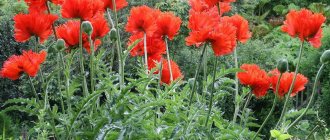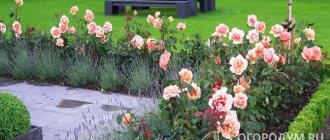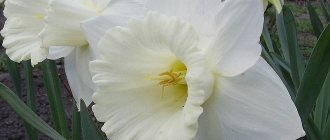Anemone is a southern perennial from the buttercup family. Planting anemones outdoors in autumn is practiced in regions with long, hot summers and mild winters. This is a delicate plant that does not tolerate extreme heat and cold. There are about 170 species of anemone, differing in the type of root system. Flowers with rhizomes are unpretentious and easy to care for. But hybrid tuberous varieties are capricious and require constant attention. It is advisable to dig them up for the winter and store them until warm in a cool, dry place.
When to plant anemones: autumn or spring
Outdoors, anemones are planted in autumn and spring. Sowing before winter is carried out to obtain early flowering dates. In order not to spoil the planting material and enjoy the results of your labors in the spring, you need to pay special attention to the plant. Anemone winters well under dense snow cover. Freezing of the soil is detrimental to it; the area with plantings should be covered for the winter. If you decide to plant anemone in the fall in a region with harsh winters, you need to understand that the risk of the plant dying is very high.
Sortoseria de Caen
Crown anemone variety de Caen most often comes on sale in the form of a mix, that is, a mixture of varieties. You need to buy anemone planting material only in large garden centers, and it should be packaged, with the manufacturer’s label, which must have a sell-by date. It is not easy to achieve germination of Anemone de Caen tubers, they are expensive, and it is not worth buying tubers from your own hands. Very rarely, not a mixture, but a specific variety goes on sale.
Important! Often when labeling you can see the mark “parsing corms”, the numbers below indicate the diameter of the anemone roots, which should be in the package.
Crowned anemones are used by florists to make bouquets; they can be grown in greenhouses for cutting and winter forcing. Anemones planted in September or October will bloom in March-April. If the tubers are placed for germination in the first half of spring, the buds will appear by the end of summer.
We bring to your attention a brief description of several popular varieties of anemone de Caen with photos. They will demonstrate the striking beauty of the flowers.
Bicolor
A beautiful single white flower with a red ring in the middle, large, 6-8 cm in diameter. A crown anemone bush about 20 cm high with dissected sessile leaves is used for planting in flower beds. The Bicolor de Caen variety has proven itself to be the most resistant to low temperatures and in the south can be grown without digging, under good cover.
Sylphide
A short variety of crown anemones with bushes about 20 cm in size, which with regular feeding can grow up to 30. Each can grow more than ten flower stalks. The color of the buds is lilac, the shade depends on the lighting, the composition of the soil and fertilizing. Single flowers of the anemone Sylphide de Caen with a diameter of 5-8 cm are decorated with purple stamens.
The variety performed well when grown in flowerbeds and forced.
Bride
The height of the anemone is 15-30 cm. Single buds with a shape like a poppy with a diameter of 5-7 cm are painted white with a pearlescent hue, with salad or yellow stamens. Anemones look unusually impressive and serve as decoration for flower beds, containers and garden beds. Florists love this flower and are happy to use it when arranging bouquets.
Crowned anemone Bride de Caen should be planted in partial shade, since in the sun the delicate white petals lose their decorative effect and quickly fade.
Holland
Bright red anemone with black stamens and a narrow snow-white stripe in the center. From a distance or when the bud is not fully opened, this anemone can be confused with a poppy. A bush 15-30 cm high with dissected leaves is resistant to diseases. Anemone Holland de Caen looks great in a flowerbed, planted in a large mass or when creating bouquets.
Mr. Fokker
The color of this anemone is very unusual; it is purple. The color can be saturated or slightly blurred, depending on the lighting and the ground. Bush 30 cm high with sessile dissected leaves. The anemone Mr. Fokker de Caen is grown in flower beds as a focal plant, in containers and for cutting.
If anemone is planted in the shade, the color will be bright; in the sun the petals will fade a little.
When to plant anemones in the fall
The timing of planting anemones in open ground depends on climatic conditions. The optimal temperature during the rooting period is + 9 + 12 ˚С. In the subtropics it is best to do this at the beginning of November, in temperate latitudes - at the end of September and October. The flower propagates in 2 ways:
- plant parts: tubers that divide the bush or rhizomes.
- seeds;
Gardeners prefer to plant tubers on anemones. This method allows, with proper care, to obtain stable seedlings and flowers of good quality.
How to soak tubers
Before planting, tubers are sorted by size, rotten and moldy ones are thrown away. They will no longer produce a good harvest, no matter how careful the care is. It is recommended to soak them for half an hour in a pink manganese solution. Then place it in a napkin moistened with water or a root formation stimulator (Epin, Zircon, Atlet, Kornevin, etc.), cover with a plastic bag to form an air cushion inside, and store in a cold place with a high temperature not exceeding + 6˚С - for example in a refrigerator. Under these conditions, they will begin to awaken to give the first roots and growth points.
How to prepare seeds
To plant anemones in the ground, it is recommended to use freshly collected seeds - they have a short shelf life. Their main drawback is low germination rate, about 25%. This figure can be increased when exposed to low temperatures, so autumn planting will be beneficial. The seeds are placed in a damp mixture of peat and sand and left to swell.
Planting container and soil
Of the variety of containers for planting, it is best to choose wide, shallow boxes with holes in the bottom to drain excess moisture. The bottom layer is drainage made of small pebbles or broken bricks, above it is a soil mixture consisting of peat, ash and coarse sand.
Planting anemones with tubers in autumn
After soaking, the tubers are planted in the ground. Depending on their size, planting is carried out according to the following scheme:
- More than 1 cm – 20 x 20 cm;
- If the tuber diameter is less than 1 cm, the distance between them is 10 x 20 cm;
- Diameter 1 – 1.5 cm – 15 x 20 cm;
It is undesirable to delve into planting material. It is recommended to prepare the hole, press the tuber to the ground, lightly sprinkle and water generously. After germination, cover completely with soil.
Important! It is good to place the tubers in peat cups - then they will be in an optimal nutrient medium, and it is convenient to plant them in the ground.
Planting Anemone Seeds
After swelling, place the seeds in a container with a moist soil mixture consisting of sifted soil, compost humus and coarse sand, keep at + 5 ° C until seedlings emerge. Then bury the garden until the end of winter, covering it with sawdust, straw or potting soil. This must be done before frost sets in. No additional care required. With the onset of heating, the container is removed.
Seedling care
Autumn care for anemones involves regularly moistening the soil before planting it in the ground. Next, the seedlings need to be covered with sawdust, straw, dry leaves or branches of coniferous spruce.
Reproduction
You can propagate crown anemone:
- using seeds and
- dividing adult tubers.
When propagated by seed, varietal characteristics are not always preserved, since this plant undergoes quite strong gene splitting. To preserve valuable varieties, it is better to use vegetative propagation.
Propagation by seeds is described above in the section “Growing anemones from seeds.”
To divide tubers, plants older than 5 years are used. The best time for division is spring. Parts are cut off from the tuber with a sharp knife, each of which has 2-3 renewal buds. There is no need to thoroughly clear the soil from the mother tuber before dividing.
Next, the cuttings are processed and planted as described in the section “Planting anemone with tubers.”
How to plant anemones in open ground in the fall
Before planting anemones in the fall, you should decide on a permanent place where they will grow and prepare the soil.
Landing location
Anemones love slightly raised places that prevent stagnation of water in the ground. It is necessary to choose a large semi-shaded area, protected from drafts. A year after planting, anemones grow greatly - this must be taken into account when choosing a site. Choosing the right site is the key to good germination and development of healthy plants.
Important! The degree of illumination depends on the variety. Oak and forest species (Altai, Ten, Lyutichnaya, Dubravnaya) prefer deep shade.
How to prepare the soil
Anemones are grown on fertile, light and loose soils - clay and sandy. They do not grow well in acidic soils; a neutral or alkaline environment (pH 5.5 - 7.5) is suitable for them. Before planting, plants are loosened in the fall and peat, mature compost and wood ash are added for fertilizer. If the soil is too heavy, you need to add sand; if it is too acidic, dolomite flour.
Tuber hole
The size of the anemone hole depends on the tuber. The depth, as a rule, should not exceed 2-3 its height, the width - 30 cm. Humus and ash are laid at the bottom of the pit. After planting, the soil is covered with mulch.
Landing location
So, we found out when to plant anemones and that early-flowering or tuberous anemones cannot be placed on the site in the fall. The next essential point in growing a flower is choosing the right place for it.
- All rhizomatous ephemeroids are shade-loving. They should be planted under the canopy of trees or on the north-facing side of the site.
- Most types of anemone can be grown in partial shade.
- Only on the southern slopes are plantings of crown anemone, Caucasian, tender, and Apennine anemone planted. In the middle zone they simply do not have enough light.
Important! What all anemones have in common is their dislike of drafts. Be sure to take this into account when planting and caring, otherwise the flower petals will fly off even in a light wind.
Caring for anemones in the open ground
Caring for anemones in the fall comes down to moisturizing, gentle loosening and treatment for pests and diseases.
Feeding
In autumn, organic fertilizers are added to the soil. It should be remembered that anemones do not tolerate manure well. The best way to compost is from the leaves of fruit trees. In order for the treatment to be complete, it is necessary to add mineral fertilizers containing potassium and magnesium to the soil.
Watering
You need to water the anemone in the fall as needed, no more than once a week. Care should not be excessive - excess moisture will lead to rotting of the planting material and death.
Preparing for winter
The main concern of the gardener is to protect the soil from freezing. To do this, the plantings are covered with a thick layer of dry plants, branches or specially developed roofing material made of polypropylene fiber (agrospan, spanbod, spantex).
Disease Prevention
Anemone is susceptible to certain diseases. To prevent their appearance, plants require preventive care: they are treated with organic products Planriz, Fitosporin-M, Rovral.
Pest Control
The anemone is defenseless against aphids, South American miners, thrips, greenhouse whiteflies and tobacco. The drugs Actara, Actellik, and Iskra are effective against them. Treatment must be carried out in the early stages of the injury. If a plant is affected by a nematode, it is used entirely and is not used for propagation. The metaldehyde solution will help with plugs and plugs. Treatment consists of modern identification and elimination of the problem.
Trimming
As a rule, pruning is not required to care for anemone, even if it is dug up in the fall. In the subtropics, tall species are cut down to ground level. In areas with harsh winters, the stems are left and the plant is covered.
Anemone propagation
Anemones reproduce best by vegetative means: by dividing rhizomes, dividing a bush, or by root suckers. The best time for this type of farming is spring. Sowing in autumn gives good results.
Origin
Numerous legends composed about the flower by the ancient peoples of the Mediterranean express its presence and significance back in ancient times.
Despite the various variations of legends, the meaning of the flower and its appearance remains unchanged. The ancient Greek Goddess of love and beauty Aphrodite, struck by the grief of the loss of her beloved Adonis, mourned him for a long time at the place of death - her tears turned into scatterings of anemones.
Extraordinary tenderness and grace, the brightness of the color of the petals symbolize greatness and sorrow, chastity and trembling. Ancient girls decorated their heads with wreaths of anemones; they served as a talisman against evil spirits and misfortunes.
The mystery of the flower and its “unearthly” origin were reflected by ancient painters in their paintings with divine characters.
Christian biblical legends say that numerous anemones grew on Calvary after the execution of Christ. The blood of Christ poured out the purple color of the petals. The new Christians, the Palestinians, used the trefoil anemone as a symbol of the Holy Trinity.
The lightness of the petals and the flexibility of the thin peduncle, set in awe by the slightest vibration of the air, served as the second name of the flower “anemone” and the name of the genus, anemone translated from Greek means “daughter of the winds.”
The use of crown anemone in breeding dates back to 1600. Tubers brought to Europe from the countries of Asia Minor gained popularity in Italy, France, Germany, and Holland. Actively cultivated in North America. Modern breeding work in Russia is carried out at the Sochi Center.
Reference! Crown anemone belongs to the group of ephemeroids - perennial herbaceous plants that have the ability to go through all stages of growth in a short period of time: from the appearance of shoots to the ripening of seeds.
Replanting anemones in the fall
Flowers can be easily replanted at any time - even during the flowering period, the optimal time of year for this is spring. If necessary, you can replant the anemone in the fall; do not miss the moment when the above-ground part dries out. In August-September, the area with anemones must be dug up, the underground parts removed and planted. No special care required. Transferred plants need to be watered and covered abundantly.
Adenoma flower. Homeland and appearance of adenium
The homeland of adenium is Africa, however, the appearance of the plant is completely out of harmony with the hot climate of the continent. In addition, the flower is found in Saudi Arabia, Oman, Yemen, but the plant is grown as an ornamental crop in India, Malaysia and Thailand.
Under natural conditions, adenium grows in height and width up to several meters, and on the windowsill the flower is a miniature tree no more than half a meter high.
In indoor floriculture, the most popular is considered to be Adenium Tuchny - one of the most unpretentious types of flower. As for the shape and color of the inflorescences, breeders have developed varieties with white, red and even black petals, and variegated inflorescences are also found. The structure of the inflorescence can be simple, semi-double or double; the petals have a smooth edge or a wavy one. The leaves are not inferior to flowers in decorativeness: they are green, yellow, red, variegated, with an edging along the edge, with a velvet surface, narrow and wide.
The unusual thick trunk of light or almost black shades gives the plant a special exoticism.
Adenium is characterized by very slow growth, so gardeners should be patient. The first flowers appear in the second year of life and stay on the branches for about a week and a half.
Particular care should be taken when working with the plant, since adenium juice is poisonous. All work with the flower should be carried out with gloves, under no circumstances should you rub your eyes, and upon completion of work, wash your hands thoroughly with soap. It is not recommended to grow adenium in apartments and houses where there are small children and animals, although it is believed that dogs and cats can recognize poisonous plants, it is better not to risk the pet’s health.
It is not for nothing that adenium is so popular among flower growers. The plant has an amazing exoticism combined with unpretentiousness. In the warm season, adenium decorates the room with lush green leaves and delicate inflorescences, and in winter you will have a kind of bonsai in your house with an original, thick stem that ends with powerful roots reminiscent of intertwined snakes.
If you want to choose the most unpretentious adenium, pay attention to the variety with oblong, round, plain leaves. Adenium with variegated leaves is more demanding on growing conditions and may not bloom as profusely.
Reviews
Fedina Valeria Gennadievna, 35 years old, Sergiev Posad I always wanted to plant anemone. I bought bulbs of the Admiral variety. I am happy, such an elegant and beautiful flower. I planted it, I didn’t plant it for 3 years, I just watered and fertilized it. Winters well in snow. Lukoshina Alexandra Ilyinichna, 45 years old, St. Petersburg I have been breeding anemones for many years. They are my love. This year the Lord Lieutenant filled his collection with chic looks. Blue, terry, velvety: this is the pride of my garden.
Source – https://agrognom.ru/flowers/posadka-i-uhod-za-anemonoj-osenyu.html
The most popular varieties
There are a huge number of species. Some of them bloom in spring, others, on the contrary, in summer or autumn. Some love the shade, others love the sun. There are frost-resistant and heat-loving species . Below are some of the most popular types.
Crown anemone
Crowned anemone is the most beautiful anemone. The flowers of this plant are quite large and come in a variety of colors. But this type of plant is extremely demanding on the environment. It is recommended to dig up the crown for the winter. In this case, the usual cycle is completely disrupted.
If in nature it begins to bloom in early summer. After flowering, its leaves dry out completely. And in the fall it blooms again. Then, when planted in spring, it blooms in mid-summer, and the second flowering occurs along with frost and snow.
crown
De Caen
The De Caen variety belongs to the crown type. Blooms in early summer. And in the fall it repeats. Flowers of this variety are distinguished by a huge variety of shades. The bush is lush, grows up to 45-55 centimeters in height.
De Caen
Tender
Tender - the plant is frost-resistant, unpretentious. It is distinguished by its small size. up to 5-10 centimeters in height . The plant blooms in early spring. Flowers bloom along with leaves. The flowers are blue, white and pink. Tender blooms for 2-3 weeks.
White
White or oak forest is the most tenacious and unpretentious among other species. Blooms in early spring for 3-4 weeks. The height of the bush is 20-25 centimeters, and the flowers are 2-3 centimeters in diameter. Dubravnaya is most often found with white flowers.
White
Ordinary
The common anemone blooms in early spring. The flowers look like bells. It does not require special care . The planted seeds will bloom only after two years. But then they will delight you for many years and will not require any care.
Ordinary
Top dressing
Top dressing 1 (before planting in the ground), options:
- aqueous solution of mullein (1:10);
- 2-year compost (4 kg/sq.m);
Feeding 2 (during flowering and every 2 weeks), options:
- liquid humic fertilizer PETER PEAT “Living force: for flower crops” (see dosage on the package);
- an aqueous solution of bird droppings.
Feeding 3 (autumn, before winter), options:
- 8-10 g nitrogen + 15-20 g phosphorus + 10-15 g potassium fertilizer;
- complex mineral fertilizer PETER PEAT “NPK 15-15-15” of the MINERAL line.
Diseases and pests, combating them
In most cases, anemone does not become infected with diseases. But with improper care, there is a chance of triggering the development of the following pathogenic bacteria:
- Anthracnose is a fungal infection that leads to slow growth and leaf curl. Young shoots appear ugly and twisted. Anemone growth in such a situation is darkened and flimsy. To prevent the appearance, it is recommended to periodically monitor the emerging leaves. If you detect the first signs of illness, immediately resort to chemical drugs (Euparen or Cumulus).
- Gray rot - infected leaf blades and other areas become soft and watery to the touch. Due to increased air humidity, gray rot forms on the foliage. The disease appears in autumn or spring, when the climate changes from warm to cold and vice versa.
- Downy mildew - a white coating forms on the surface of the leaf blades. If you turn the leaf over, a gray rim of fungal spores will be present in the same place. As a preventive measure, when growing seedlings in a greenhouse, it is necessary to monitor air humidity and spray the plant less. Diseased plants are removed, and the remaining ones are irrigated with chemicals that prevent infection.
Most often, parasitic insects such as aphids, thrips, nematodes, South American leaf miner and whiteflies like to settle on the plant. If a small number of parasitic individuals are detected, it is more advisable to remove them manually. But if an increased population is detected, exposure to chemicals cannot be avoided.
To prevent diseases from developing on the leaf blades and to prevent pests from infecting the shrub, it is necessary to constantly monitor the delicate pet. If the first signs of a disease or parasite invasion are detected, you should immediately apply therapeutic actions and not wait for events to develop.











